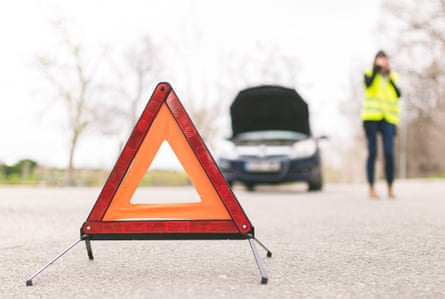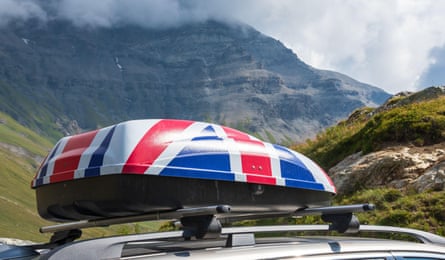Check your documents …
If you are driving your own car to mainland Europe this year, there are plenty of things to think about in addition to how you are going to fit all your stuff in the vehicle.
Most European police will want to see your driving licence if they pull you over – check yours is still valid and renew it online if it has expired, or is about to. They will also ask for proof of insurance and your vehicle logbook (V5C), if you have one.
You don’t need an international driving permit in the EU, Switzerland, Liechtenstein, Norway or Iceland if you have a photocard licence issued in the UK.
However, if you have a paper licence, you will need to update it to a photocard or get an IDP. Go to gov.uk/driving-abroad for details.
… and what gear to pack
Some countries require drivers to carry certain things. For example, in much of Europe, including popular destinations such as France, Italy and Germany, you need a warning triangle. In some countries, including Germany and France, you will need a hi-vis vest, too.
Don’t forget to use headlamp beam converter stickers to stop your headlights dazzling other road users. These are compulsory in places such as France. They can be bought easily for a few pounds.
If you don’t have these things, an easy option is to pick up a European driving kit from retailers such as Halfords (£32.50 at time of writing) or the RAC (from £25.99).

Use a ‘UK’ sticker
You will need a sticker for your vehicle if your number plate doesn’t include the UK identifier with the union flag.
If it has a GB identifier with the union flag, a euro symbol, a national flag of England, Scotland or Wales, or numbers and letters only, you must display a UK sticker clearly on the rear of your vehicle.
If you are in Spain, Cyprus or Malta, you must display a UK sticker no matter what is on your number plate.
However, you don’t need a UK sticker or identifier to drive in Ireland.
Ensure you’re insured
All UK car insurance policies automatically provide you with third-party cover while in EU countries, plus a few others including Switzerland. This covers your legal liability to others – for example, if you injure someone in an accident or damage their property – but won’t cover damage to your own vehicle.
Most people will want to take their comprehensive cover with them, so check with your provider to see what is, and isn’t, included in your policy. The good news is that plenty of insurers automatically include driving elsewhere in Europe with their comprehensive cover. For example, with LV= you are covered for up to 180 days over the policy year, while all of Admiral’s comprehensive insurance, except for its Essential policies, includes 90-day European cover.

Bear in mind that with some companies you may only be covered for 30 days over the year.
With others, such as Aviva, you only get third-party cover as standard, and if you want comprehensive for driving in Europe, you have to buy a policy add-on.
Alternatively, you can buy short-term European car insurance from another provider to cover your trip. You can get this through a price comparison website. “You might find this to be an easier solution than adding cover to your existing policy,” MoneySuperMarket says.
Get breakdown cover
Again, check if you are already covered. New cars often come with European roadside assistance, or breakdown cover, while the vehicle is in warranty. It may also be included in a monthly service plan or if you have the car serviced at a main dealer.
A number of bank accounts – particularly paid-for ones – include European breakdown cover. Among them are Nationwide’s FlexPlus (which costs £18 a month), Monzo’s Max (from £17 a month) and the Co-operative Bank’s Everyday Extra (£18 a month).
Barclays offers customers a “travel pack” add-on, costing £14.50 a month, that includes European breakdown cover and worldwide travel insurance (there is a six-month minimum term).
If you don’t have any European breakdown cover, a few weeks’ worth should not break the bank.
A Compare the Market comparison of single-trip policies for a 2019 Volvo V40, based on two weeks in France in August, found the cheapest policy was £31.79 from Cover My Breakdown.
However, for a big road trip, unless you have a super-reliable car that has not given you any problems, it may be wise to go for something offering a bit more than a budget policy. For the scenario mentioned, the RAC would charge either £82.30 or £133.74 depending on the level of cover, while the AA wants £100.03, or £85.74 if you are a member.
Beware clean air rules
If you are driving to France, you need to be aware of the country’s low emission zones, and the clean air sticker – called a Crit’Air vignette – that you are required to display if you plan to enter one of a number of urban areas.
These stickers are used to identify the vehicle’s emission levels and, in some cases, restrict access in order to improve air quality.
“Although France’s National Assembly voted [in May this year] to scrap low emission zones (ZFEs), the rules around Crit’Air stickers haven’t changed yet. UK drivers still need the right sticker to enter many French cities,” the RAC spokesperson Rod Dennis says.
Fail to comply and you could face a fine of up to €180 (£155).
There are six categories in the Crit’Air vignette system, from green for the cleanest vehicles (for example, 100% electric) to dark grey for the dirtiest.

Drivers need to apply via the official French government website and ensure their sticker is displayed before they enter France – so do not leave this until the last minute. For British vehicles, the sticker costs €4.91 (£4.23) including postage.
Le Havre and its port are within a low emissions zone, says Brittany Ferries, while other cities operating zones include Caen, Rouen, Rennes and Nantes. Paris and Lyon have particularly strict rules.
The RAC has a useful webpage with lots of information on the scheme and which towns and cities need a sticker, and the French government website for the scheme has information and a map.
Think tolls
When planning your trip, don’t forget to factor in the cost of any motorway tolls and consider how you will pay them.
It now costs about €125 (£107) in tolls to drive from Calais to Nice on the south coast of France (so roughly double that for a return trip). You can avoid them, but this will almost certainly add time to your journey.
ViaMichelin has a useful tool at viamichelin.co.uk/routes that will calculate the estimated total cost of tolls and fuel for your journey.
There are payment services you can sign up to that let you use the automated lanes so you can drive straight through and beat any queues, but unless you are planning a lot of journeys, it’s probably easier to pay as you go by credit card at the booths or machines. (That is, if you have a front seat passenger to lean out of their window to pay)
Emovis Tag, for example, sells tags for France, Spain and Portugal, but there are several upfront and ongoing charges, which may mean it is not cost-effective to use them for a one-off trip. If they do look good value for your break, LeShuttle’s car service is running an offer on the tags.
The RAC has useful online guides to tolls in France and Spain.

 3 months ago
98
3 months ago
98

















































